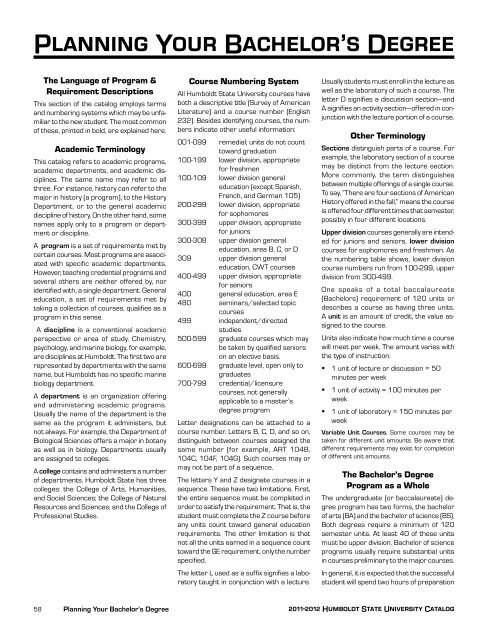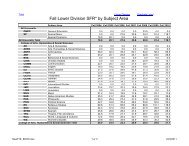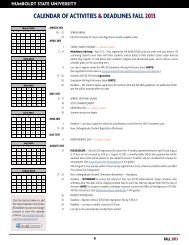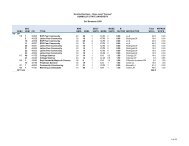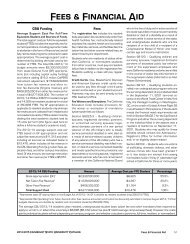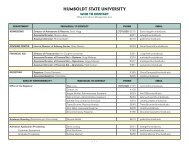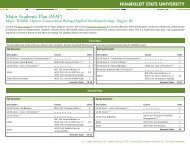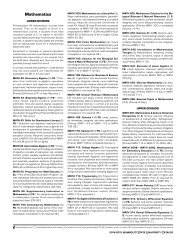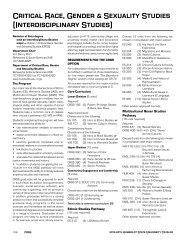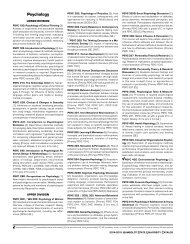2011-12 Academic Year - Bad Request - Humboldt State University
2011-12 Academic Year - Bad Request - Humboldt State University
2011-12 Academic Year - Bad Request - Humboldt State University
Create successful ePaper yourself
Turn your PDF publications into a flip-book with our unique Google optimized e-Paper software.
Planning Your Bachelor’s Degree<br />
The Language of Program &<br />
Requirement Descriptions<br />
This section of the catalog employs terms<br />
and number ing systems which may be unfamiliar<br />
to the new student. The most common<br />
of these, print ed in bold, are explained here.<br />
<strong>Academic</strong> Terminology<br />
This catalog re fers to academic programs,<br />
academic depart ments, and academ ic disci<br />
plines. The same name may refer to all<br />
three. For instance, history can refer to the<br />
ma jor in his tory (a program), to the History<br />
De part ment, or to the general academic<br />
dis ci pline of history. On the other hand, some<br />
names apply only to a program or department<br />
or disci pline.<br />
A program is a set of requirements met by<br />
certain courses. Most programs are associated<br />
with spe cific academic departments.<br />
However, teaching credential programs and<br />
several others are neither offered by, nor<br />
identified with, a single depart ment. General<br />
education, a set of require ments met by<br />
taking a collec tion of cours es, quali fies as a<br />
program in this sense.<br />
A discipline is a conventional academic<br />
per spec tive or area of study. Chemistry,<br />
psychology, and marine biology, for example,<br />
are disciplines at <strong>Humboldt</strong>. The first two are<br />
represented by departments with the same<br />
name, but <strong>Humboldt</strong> has no spe cif ic marine<br />
biology department.<br />
A department is an organization offering<br />
and administering academic programs.<br />
Usually the name of the department is the<br />
same as the program it administers, but<br />
not always. For example, the Department of<br />
Biological Sciences offers a major in botany<br />
as well as in biology. Departments usually<br />
are assigned to colleges.<br />
A college contains and administers a number<br />
of departments. <strong>Humboldt</strong> <strong>State</strong> has three<br />
colleges: the College of Arts, Humanities,<br />
and Social Sciences; the College of Natural<br />
Resources and Sciences; and the College of<br />
Professional Studies.<br />
Course Numbering System<br />
All <strong>Humboldt</strong> <strong>State</strong> <strong>University</strong> courses have<br />
both a descriptive title (Sur vey of American<br />
Literature) and a course number (English<br />
232). Besides identifying courses, the numbers<br />
indicate other useful information:<br />
001-099 remedial; units do not count<br />
toward graduation<br />
100-199 lower division, appropriate<br />
for freshmen<br />
100-109 lower division general<br />
ed u ca tion (except Spanish,<br />
French, and German 105)<br />
200-299 lower division, appropriate<br />
for soph o mores<br />
300-399 upper division, appropriate<br />
for juniors<br />
300-308 upper division general<br />
education, area B, C, or D<br />
309 upper division general<br />
education, CWT courses<br />
400-499 upper division, appropriate<br />
for sen iors<br />
400 general education, area E<br />
480 seminars/selected topic<br />
courses<br />
499 independent/directed<br />
studies<br />
500-599 graduate courses which may<br />
be taken by qualified seniors<br />
on an elective basis.<br />
600-699 graduate level, open only to<br />
grad uates<br />
700-799 credential/licensure<br />
courses, not generally<br />
applicable to a master’s<br />
degree program<br />
Letter designations can be attached to a<br />
course num ber. Letters B, C, D, and so on,<br />
distin guish between courses assigned the<br />
same number (for exam ple, ART 104B,<br />
104C, 104F, 104G). Such courses may or<br />
may not be part of a sequence.<br />
The letters Y and Z designate courses in a<br />
se quence. These have two limitations. First,<br />
the entire se quence must be completed in<br />
order to satisfy the requirement. That is, the<br />
student must complete the Z course before<br />
any units count toward general education<br />
requirements. The other limitation is that<br />
not all the units earned in a sequence count<br />
to ward the GE re quire ment, only the number<br />
specified.<br />
The letter L used as a suffix signifies a laboratory<br />
taught in con junction with a lecture.<br />
Usually students must en roll in the lecture as<br />
well as the laboratory of such a course. The<br />
letter D signifies a discussion sec tion—and<br />
A signifies an activ ity sec tion—offered in conjunction<br />
with the lecture portion of a course.<br />
Other Terminology<br />
Sections distinguish parts of a course. For<br />
ex ample, the laboratory section of a course<br />
may be distinct from the lecture section.<br />
More commonly, the term dis tinguishes<br />
between multiple offerings of a single course.<br />
To say, “There are four sections of Amer ican<br />
History offered in the fall,” means the course<br />
is offered four different times that semester,<br />
possibly in four different locations.<br />
Upper divi sion courses generally are intended<br />
for juniors and seniors, lower division<br />
cours es for sopho mores and freshmen. As<br />
the num ber ing table shows, lower division<br />
course numbers run from 100-299, upper<br />
division from 300-499.<br />
One speaks of a total baccalaureate<br />
(Bachelors) re quire ment of <strong>12</strong>0 units or<br />
describes a course as hav ing three units.<br />
A unit is an amount of credit, the value assigned<br />
to the course.<br />
Units also indicate how much time a course<br />
will meet per week. The amount varies with<br />
the type of instruction:<br />
1 unit of lecture or discussion = 50<br />
minutes per week<br />
1 unit of activity = 100 minutes per<br />
week<br />
1 unit of laboratory = 150 minutes per<br />
week<br />
Variable Unit Courses. Some courses may be<br />
taken for different unit amounts. Be aware that<br />
different requirements may exist for completion<br />
of different unit amounts.<br />
The Bachelor’s Degree<br />
Program as a Whole<br />
The undergraduate (or baccalaureate) degree<br />
pro gram has two forms, the bachelor<br />
of arts (BA) and the bachelor of science (BS).<br />
Both degrees require a minimum of <strong>12</strong>0<br />
semester units. At least 40 of these units<br />
must be upper division. Bachelor of science<br />
programs usually require substan tial units<br />
in courses preliminary to the major courses.<br />
In general, it is expected that the successful<br />
student will spend two hours of preparation<br />
58 Planning Your Bachelor’s Degree<br />
<strong>2011</strong>-20<strong>12</strong> <strong>Humboldt</strong> <strong>State</strong> <strong>University</strong> Catalog


